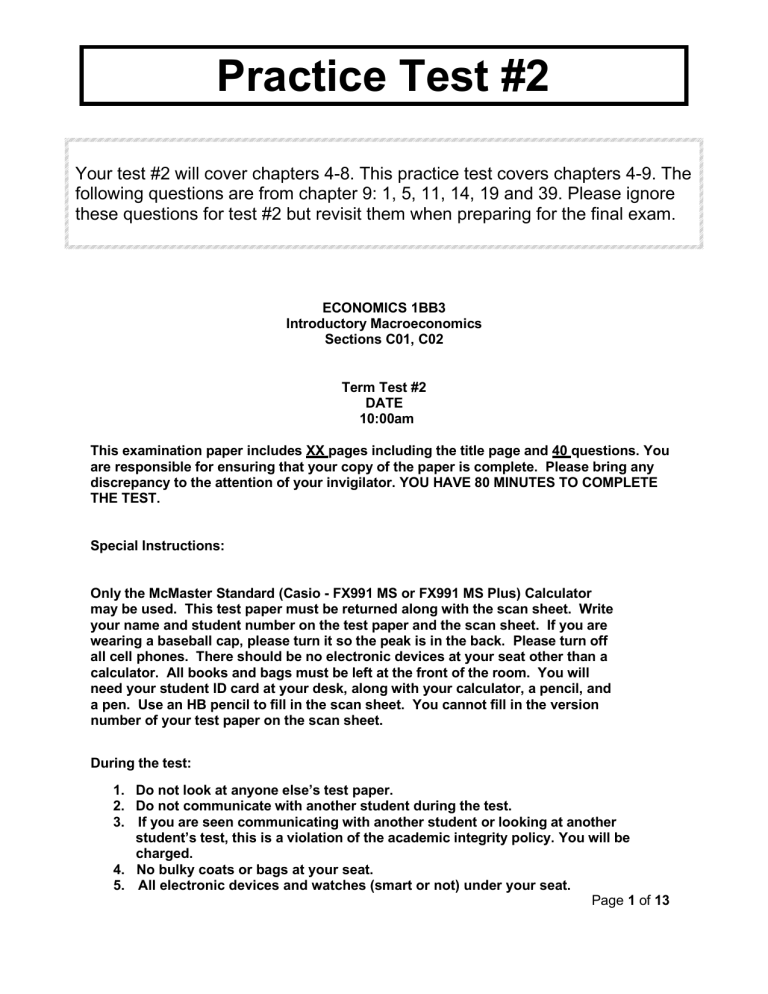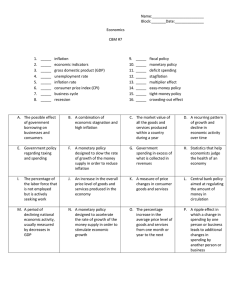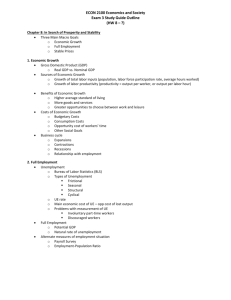
Practice Test #2 Your test #2 will cover chapters 4-8. This practice test covers chapters 4-9. The following questions are from chapter 9: 1, 5, 11, 14, 19 and 39. Please ignore these questions for test #2 but revisit them when preparing for the final exam. ECONOMICS 1BB3 Introductory Macroeconomics Sections C01, C02 Term Test #2 DATE 10:00am This examination paper includes XX pages including the title page and 40 questions. You are responsible for ensuring that your copy of the paper is complete. Please bring any discrepancy to the attention of your invigilator. YOU HAVE 80 MINUTES TO COMPLETE THE TEST. Special Instructions: Only the McMaster Standard (Casio - FX991 MS or FX991 MS Plus) Calculator may be used. This test paper must be returned along with the scan sheet. Write your name and student number on the test paper and the scan sheet. If you are wearing a baseball cap, please turn it so the peak is in the back. Please turn off all cell phones. There should be no electronic devices at your seat other than a calculator. All books and bags must be left at the front of the room. You will need your student ID card at your desk, along with your calculator, a pencil, and a pen. Use an HB pencil to fill in the scan sheet. You cannot fill in the version number of your test paper on the scan sheet. During the test: 1. Do not look at anyone else’s test paper. 2. Do not communicate with another student during the test. 3. If you are seen communicating with another student or looking at another student’s test, this is a violation of the academic integrity policy. You will be charged. 4. No bulky coats or bags at your seat. 5. All electronic devices and watches (smart or not) under your seat. Page 1 of 13 OMR EXAMINATION - STUDENT INSTRUCTIONS NOTE: IT IS YOUR RESPONSIBILITY TO ENSURE THAT THE ANSWER SHEET IS PROPERLY COMPLETED: YOUR EXAMINATION RESULT DEPENDS UPON PROPER ATTENTION TO THESE INSTRUCTIONS. The scanner, which reads the sheets, senses the shaded areas by their non-reflection of light. A heavy mark must be made, completely filling the circular bubble, with a HB pencil. Marks made with a pen or felt-tip marker will NOT be sensed. Erasures must be through or the scanner may still sense a mark. Do NOT use correction fluid on the sheets. Do NOT put any unnecessary marks or writing on the sheets. 1. Print your name, student number, course name, section number and the date in the space provided at the top of Side 1 (red side) of the form. 2. Mark your student number in the space provided on the sheet on Side 1 and fill in the corresponding bubbles underneath. 3. Mark only ONE choice from the alternatives (1,2,3,4,5, or A,B,C,D,E) provided for each question. If there is a True/False question, enter response of 1 (or A) as True, and 2 (or B) as False. The question number is to the left of the bubbles. Make sure that the number of the question on the scan sheet is the same as the question number on the test paper. 4. Pay particular attention to the Marking Directions on the form. 5. Begin answering questions using the first set of bubbles, marked “1". Page 2 of 13 INSTRUCTIONS: Choose one alternative that best completes the statement or answers the question. 1) Which of the following will shift the aggregate demand curve to the right, ceteris paribus? A) an increase in net exports B) a decrease in government spending C) a decrease in disposable income D) an increase in interest rates 2) If a Canadian firm opens a production facility in India, the total value of the production will be included in the A) gross domestic product of India. B) net national income of Canada. C) national income of India. D) gross domestic product of Canada. 3) Ahmed and Jennifer purchased a new house in Hamilton on July 1, 2015 for $450,000. Their mortgage payments were $2500 per month. A similar house in their neighbourhood rented for $2200 per month. Which of the following statements about Canadian GDP components is correct? A) 2015 investment spending rose by $450,000 and consumption spending rose by $15,000. B) 2015 consumption of durable goods rose by $450,000 and investment spending was not affected. C) 2015 investment spending rose by $450,000 and consumption spending was not affected. D) 2015 investment spending rose by $450,000 and consumption spending rose by $13,200. Page 3 of 13 Figure 8.1 4) Refer to Figure 8.1. At point L in the figure above, which of the following is true? A) Actual inventories are greater than planned inventories. B) Government spending will decrease. C) Aggregate expenditure is greater than GDP. D) GDP will be increasing. 5) Stagflation occurs when A) inflation rises and nominal GDP rises. B) inflation falls and nominal GDP falls. C) inflation rises and real GDP falls. D) inflation falls and real GDP falls. 6) In a closed economy, public saving is equal to which of the following? (Y = GDP, C= Consumption, G = Government purchases, T = Taxes, and TR = Transfers) A) Y - G - T B) Y - C - T C) Y - C - T + TR D) T - G - TR Page 4 of 13 7) The consumer price index implies that the demand curve for each good and service in the representative market basket is A) positively sloped. B) horizontal. C) negatively sloped. D) vertical. 8) When the economy enters a recessionary phase of the business cycle, unemployment tends to A) decrease. B) be unchanged. C) increase. D) change in the same direction as the rate of inflation. 9) Borrowers are of loanable funds, and lenders are of loanable funds. A) suppliers; suppliers B) demanders; demanders C) demanders; suppliers D) suppliers; demanders Table 5.3 Product Cokes Hamburgers CDs Quantity 100 200 10 Base Year (2002) Price $0.50 2.00 20.00 2014 Price $0.75 2.50 21.00 10) Refer to Table 5.3. Assume the market basket for the consumer price index has three products — Cokes, hamburgers, and CDs — with the above values in 2002 and 2014 for price and quantity. The Consumer Price Index for 2014 equals A) 75. B) 121. C) 108. D) 93. Page 5 of 13 Figure 9.5 11) Refer to Figure 9.5. Suppose the economy is at point A. If consumer spending increases in the economy, where will the eventual long-run equilibrium be? A) C B) D C) A D) B 12) If inventories decline by more than analysts predict they will decline, this implies that A) actual investment spending was equal to planned investment spending. B) actual investment spending was greater than planned investment spending. C) actual investment spending was less than planned investment spending. D) there is no relationship between actual investment spending and planned investment spending. 13) Consumption spending is $16 billion, planned investment spending is $4 billion, unplanned investment spending is $2 billion, government purchases are $6 billion, and net export spending is $1 billion. What is aggregate expenditure? A) $27 billion B) $26 billion C) $23 billion D) $22 billion Page 6 of 13 14) When the price level in Canada falls relative to the price level of other countries, will fall, will rise, and will rise. A) net exports; incomes; exports B) imports; exports; net exports C) net exports; imports; exports D) exports; imports; net exports 15) Ferrari produces exotic cars in Italy, most of which are exported to foreign countries. What happens when the price of these cars rises? A) Italian CPI and GDP deflator are both unchanged. B) Italian GDP deflator rises; Italian CPI is unchanged. C) Italian GDP deflator and CPI both rise. D) Italian CPI rises, but Italian GDP deflator is unchanged. 16) The diagram above shows output per worker as a function of natural resources per worker. What happens to the production point if there is an increase in physical capital? A) It moves from A to B B) It moves from B to A C) It moves from A to C D) It moves from C to A Page 7 of 13 17) Suppose that in 2018, the net national income in Madeupistan was $20 billion, depreciation was $1.5 billion, personal taxes were $2 billion, and transfer payments were $1 billion. Gross domestic product in 2018 is A) $22 billion. B) $18.5 billion. C) $21.5 billion. D) $24.5 billion. Figure 8.6 18) Refer to Figure 8.6. Potential GDP equals $100 billion. The economy is currently producing at point K where GDP is equal to $90 billion. If the MPC is 0.8, then how much must autonomous spending change for the economy to move to potential GDP? A) -$2 billion B) $18 billion C) -$18 billion D) $2 billion 19) A decrease in investment causes the price level to in the long run. in the short run and A) increase; increase further B) increase; decrease C) decrease; increase D) decrease; decrease further Page 8 of 13 20) If cyclical unemployment is eliminated in the economy, then A) the unemployment rate will be zero. B) the unemployment rate is below the natural rate of unemployment. C) the unemployment rate is above the natural rate of unemployment. D) the economy is considered to be at full employment. Table 8.3 Consumption (dollars) $1,200 2,100 3,000 Disposable Income (dollars) $3,000 4,000 5,000 21) Refer to Table 8.3. Given the consumption schedule in the table above, the marginal propensity to consume is A) 0.3. B) 0.6. C) 0.9. D) 0.1. 22) Imagine that you borrow $5,000 for one year and at the end of the year you repay the $5,000 plus $600 in interest. If the inflation rate was 4%, what was the real interest rate you paid? A) 3 percent B) 12 percent C) 8 percent D) 16 percent 23) The consumption function for a closed economy is: C = 30 + 0.9 (Y + TR - T). Suppose the price level increases. Which of the following is most likely the new consumption function? A) C = 35 + 0.9 (Y + TR - T) B) C = 30 + 0.9 (Y + TR - T) C) C = 30 + 0.95 (Y + TR - T) D) C = 25 + 0.9 (Y + TR - T) Page 9 of 13 24) If consumers decide to be more frugal and save more out of their income, then this will cause A) a shift in the demand for loanable funds to the right. B) a shift in the supply curve for loanable funds to the left. C) a movement to the right along the supply curve for loanable funds. D) a shift in the supply curve for loanable funds to the right. Figure 8.2 25) Refer to Figure 8.2. If the Canadian economy is currently at point N, which of the following could cause it to move to point K? A) Households expect future income to decline. B) Canadians begin importing fewer goods. C) Household wealth rises. D) Government expenditures increase. 26) The aggregate production function is Y = A * F(K, L,H,N). Which of the following policies will lead to an increase in "H"? A) Providing tax breaks to firms who undertake new investment spending. B) Subsidizing firms' searches for new sources of oil. C) Stronger patent policies to incentivize research by private firms. D) Providing subsidies to colleges and universities. Page 10 of 13 27) Which of the following would you expect to increase the equilibrium interest rate? A) a change from an income tax to a consumption tax, assuming taxes collected remain unchanged B) an increase in household savings C) a decrease in the profitability of investment projects firms are considering D) an increase in the budget deficit 28) An example of business fixed investment spending is A) $200 million of unsold cars at a car dealership. B) a purchase of a home by a household. C) a purchase of a computer by an accounting firm. D) a purchase of shares in Bombardier. 29) A good measure of the standard of living is A) total nominal GDP. B) total real GDP. C) real GDP per capita. D) nominal GDP per capita. Scenario 6.1 Consider the following data for a closed economy: Y = $1 200 billion C = $800 billion I = $200 billion G = $200 billion TR = $200 billion T = $300 billion 30) Refer to Scenario 6.1. Based on the information above, what is the level of private saving in the economy? A) $800 billion B) $400 billion C) $300 billion D) $100 billion 31) When actual inflation is less than expected inflation, A) borrowers lose and lenders gain. B) borrowers gain and lenders lose. C) borrowers and lenders both lose. D) borrowers and lenders both gain. Page 11 of 13 32) If real GDP is larger than nominal GDP A) prices and output must be constant. B) prices must be higher than in the base year. C) the economy must be growing. D) prices must be lower than in the base year. 33) The period of expansion ends with a . and the period of recession ends with a A) business cycle trough; business cycle peak B) business cycle peak; business cycle trough C) business cycle trough; business cycle trough D) business cycle peak; business cycle peak 34) The marginal propensity to save is defined as A) the change in disposable income divided by the change in saving. B) the change in saving divided by the change in disposable income. C) saving divided by disposable income. D) disposable income divided by saving. 35) Stephanie has worked as a nurse for the Royal Canadian Navy. Upon her discharge (the end of her contract) she becomes a nurse at McMaster Children’s Hospital. What happens to the labour force participation rate and the employment rate? A) The labour force participation rate rises and the employment rate is unchanged. B) The labour force participation rate is unchanged and the employment rate rises. C) The labour force participation rate and the employment rate both rise. D) Both the labour force participation rate and the employment rate are unchanged. 36) Which of the following transactions represents the purchase of a final good? A) Pearson buys several tonnes of paper to print text books. B) Blackberry buys computer processors from Intel. C) Tim Hortons purchases coffee beans. D) Your father buys a new John Deere riding lawn mower. Page 12 of 13 37) In the labour market for corporate executives, what will happen if the Ontario government raises the minimum wage? A) Quantity of labour supplied will be greater than quantity of labour demanded and there will be a decrease in unemployment. B) Quantity of labour supplied will be greater than quantity of labour demanded in the market and there will be an increase in unemployment. C) Quantity of labour demanded will be greater than quantity of labour supplied and there will be an increase in unemployment. D) Quantity of labour demanded will equal quantity of labour supplied and there will not be any new unemployment in the market. 38) Which of the following is an example of human capital? A) a software program B) computers used by human resource departments C) a university or college education D) a computer 39) An increase in the price level will A) move the economy down along a stationary short-run aggregate supply curve. B) move the economy up along a stationary short-run aggregate supply curve. C) shift the long run aggregate supply curve to the right. D) shift the short-run aggregate supply curve to the right. Table 4.2 Product Shoe DVD Tomatoes Ketchup Quantity 40 100 2,000 300 Price $60.00 18.00 1.00 4.00 40) Refer to Table 4.2. Suppose that a simple economy produces only four goods and services: shoes, DVDs, tomatoes, and ketchup. Assume one half of the tomatoes are used in making the ketchup and the other half of the tomatoes are purchased by households. Using the information in the above table, nominal GDP for this simple economy equals A) $83.00. B) $5,800. C) $7,400. D) $6,400. Page 13 of 13







